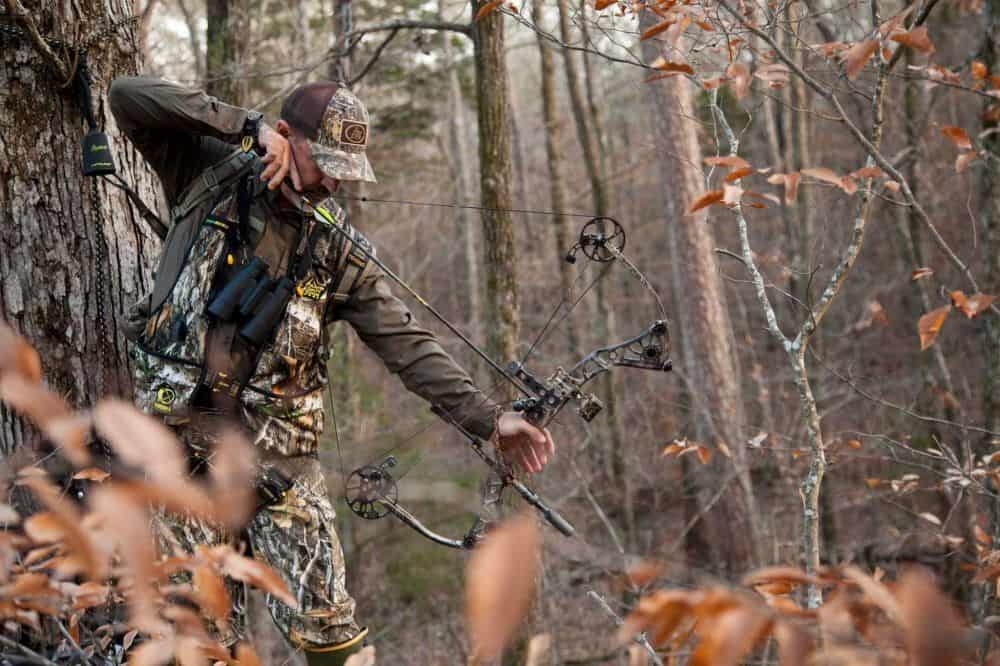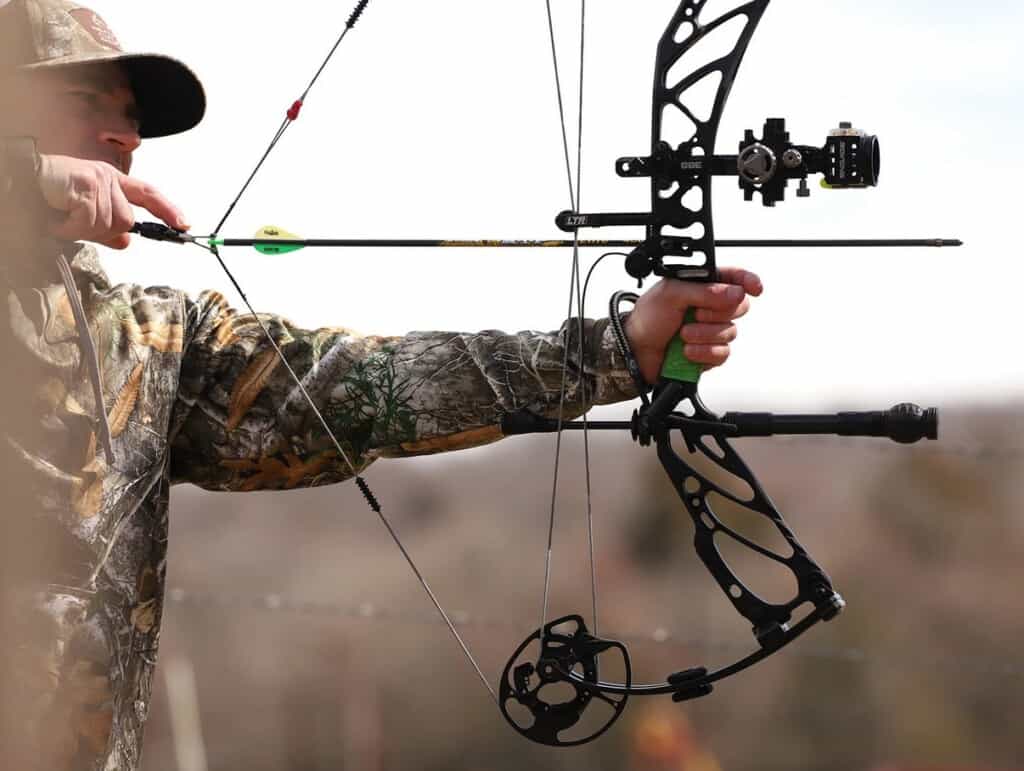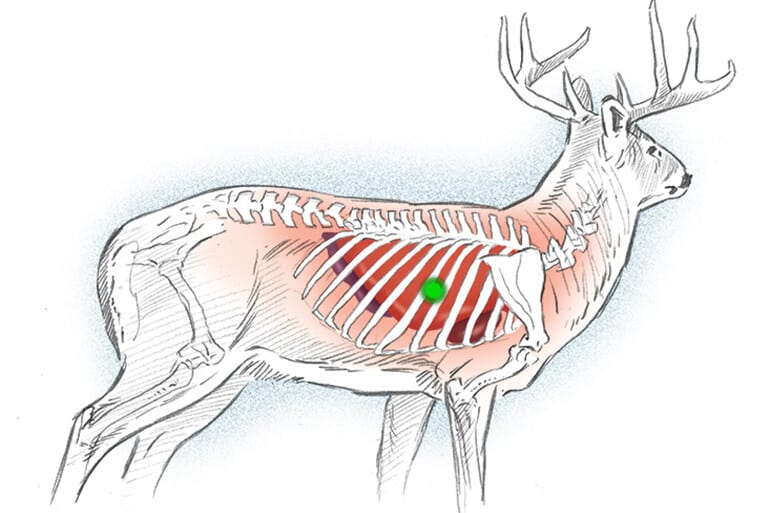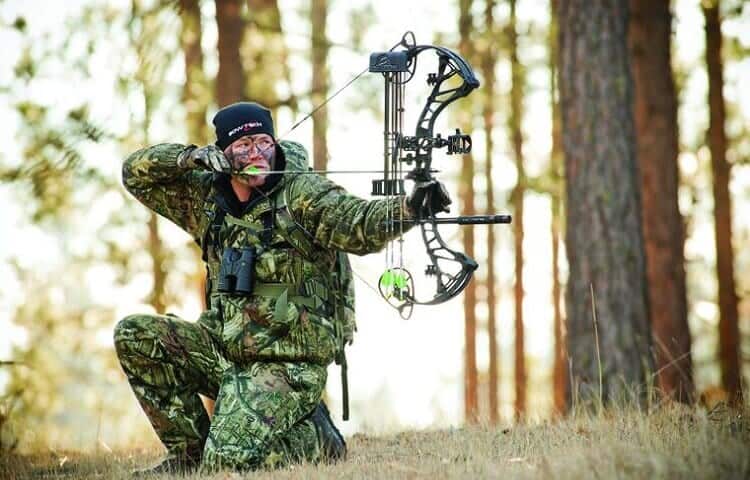We’ve all been at the range, and a shooting buddy walks in with a new Mathews bow tuned up to 80 pounds of draw weight. Flexing his muscles, he sends arrows ripping down at the targets. While it might look good at the range, is that speed worth it when whitetail hunting?
40 pounds is widely accepted as an effective bow draw weight for efficiently killing whitetail deer. Although with a higher draw weight your arrow is faster. Plus your arrow will hit harder at the same distance. This is why most hunters with compound bows shoot between 55 and 75 pounds
A higher draw weight means a faster arrow and more energy. More energy sounds nice, but when out on a hunt, if you have difficulty holding full draw or placing an accurate shot, it doesn’t matter how fast the arrow is going.
Additionally, several factors like shot distance, arrow weight, broadhead type, and tuning all play a part in bowhunting. The best bow draw weight depends on your strength, training, and preferences, so let’s get into some details.

What Is My Minimum Bow Draw Weight?
Most states have a minimum bow draw weight for ethical hunting. Here is a table of minimum bow draw weights for every state for vertical bows (compound, recurve, longbow). State regulations typically measure the peak draw weight at a 28” draw length.
If you live in a state with a 40-pound minimum, but that is past your comfort level, then that just means you have an incentive to train and develop your shooting muscles and form to hit that higher draw weight.
Part of being a good steward of wildlife is knowing your personal limits and only using ethical hunting practices. If you’re battling injuries or have another barrier stopping you from hitting the weight requirement, consider switching to another hunting method and keep the archery for the range.
This table contains the minimum bow draw requirements for deer hunting. Not all states have whitetail, but almost every state, including Hawaii, has a deer species. Some states, like Alaska, have different requirements for larger game like Elk or Bear. Make sure to check the requirements for what you plan to hunt. The name of each state links to the related regulation info. Current as of April 2022.
| State | Draw Weight Requirement (lbs) |
| Alabama | 30 |
| Alaska | 40 |
| Arizona | 30 |
| Arkansas | 35 |
| California | 40 recommended |
| Colorado | 35 – maximum let-off 80% |
| Connecticut | 40 |
| Delaware | 35 |
| Florida | No minimum – New 2021 |
| Georgia | No minimum |
| Hawaii | Comp. – 30 // Rec. – 35 // Long. – 40 |
| Idaho | 40 – maximum let-off 85% |
| Illinois | 30 |
| Indiana | 35 |
| Iowa | No minimum |
| Kansas | No minimum |
| Kentucky | No minimum |
| Louisiana | 30 |
| Maine | 35 |
| Maryland | 30 |
| Michigan | 35 |
| Minnesota | 30 |
| Mississippi | No minimum |
| Missouri | No minimum |
| Montana | No minimum – maximum 80% let-off |
| Nebraska | No minimum |
| Nevada | 40 – maximum 80% let-off |
| New Hampshire | 40 |
| New Jersey | 35 |
| New Mexico | No minimum |
| New York | 35 |
| North Carolina | Comp. – 35 // Rec. & Long – 40 |
| North Dakota | 35 |
| Ohio | 40 |
| Oklahoma | Comp. – 30 // Rec. & Long – 40 |
| Oregon | 40 |
| Pennsylvania | 35 |
| Rhode Island | 40 |
| South Carolina | No minimum |
| South Dakota | 30 |
| Tennessee | No minimum |
| Texas | No minimum |
| Utah | 30 |
| Vermont | No minimum |
| Virginia | No minimum |
| Washington | 40 |
| West Virginia | No minimum |
| Wisconsin | 30 |
| Wyoming | 40 |
Rules can change frequently, Florida just removed their draw weight requirement in 2021. Many states list their official rules and laws on eRegulations, but it never hurts to contact your local fish and wildlife office in person or over the phone before the season.
Determining Your Proper Draw Weight
How to Tell Your Max Draw Weight
As I mentioned earlier, what works at the range doesn’t always transfer to the field. When we’re shooting at the range or doing target practice on a sunny afternoon, we’ll be comfortable, standing, and in relatively light clothing.
You might feel great about your shot groups after a few hours at the range, but it can be easy to forget how much your clothes can restrict your movement on a cold morning hunt or how tight your muscles can get after sitting in the stand for hours. You can do a couple of tests to see if your draw weight is set too high or too low.
The first test is for consecutive draws. You should be able to comfortably and accurately draw and release 30 consecutive shots. If you struggle to make it to 30, odds are your setup has a draw weight too high for you to hunt well.
The second test is for holding a steady full draw. Waiting for the perfect shot when a deer walks in front of your stand can be agonizing. With a rifle, only your patience is tested. When bowhunting, on the other hand, your physical endurance is tested as well.
You should be able to comfortably hold your bow at full draw for at least 60 seconds. This ensures that you can wait for the right shot without having to redraw and risk spooking your target.

Kill Efficiency
Draw weight is the basis for determining how much energy your arrow will have when leaving the bow. While there is generally a minimum amount of energy required to penetrate through a deer cleanly, shot placement, broadhead type, and arrow weight will have significant impacts.
With a poor shot or subpar hunting arrows, you could shoot a bow with a 100-pound draw weight and still come up empty-handed.
Advancements in modern compound bows, arrows, and broadheads have given rise to many stories of hunters filling their tags with only 30-pound bows.
These stories show that you definitely do not need a 60 or 70-pound pull to take down a whitetail. What most of those hunters have in common is proper equipment, tuning, and shot placement.
Shot Placement
You can have the heaviest arrow with a wide cut diameter broadhead impacting with 100 foot-pounds of energy, but if your point of impact is in the stomach or flank, you still might end up just wounding the deer only to lose it and have it die in a ditch somewhere days later.
Your draw weight should be light enough that you can reliably make a kill shot every time.
Disrupting blood flow and oxygen delivery to the brain is what ultimately causes death. The quickest and most reliable method to do this is landing a clean shot to the heart or lungs. With the shoulder bones protecting some of the vital tissue, you have a roughly 8” x 6” area to aim at on an average deer.
Rifle hunting allows for several shot angles, however, there are only a handful of shot angles and aiming points you should attempt while bow hunting. This article from bowhuntingmag.com explains the different scenarios you can encounter bowhunting whitetail and how to adjust your aim for different quarters.
The key takeaway is that you should only attempt broadside and quarter-away shots.

Maximum Effective Range
Remember how we said the average area for a kill shot is about 8” by 6”? This means when you’re practicing, you should define your accuracy by 6” groups.
Additionally, It’s good practice to train well past the distance you expect to take a hunting shot. For example, if you expect to take a shot at 20 yards, you should be able to consistently get <6” groups at 40 yards while training.
If you can’t reliably make that grouping, you should re-evaluate your maximum effective hunting range.
Additionally, you’re not setting yourself up for success if you only practice on level ground shooting at a broadside target. If you know you will be hunting out of a stand; then you need to practice taking shots from the stand.
If you haven’t consistently shot from a stand before, you would be surprised how much of a difference it can make.
Similarly, you should train in many different weather conditions. There is a massive difference between tolerating a shot in the cold and training to take a shot in the cold.
Knowing your maximum effective range is all in your training. You just have to practice time and time again and see how far you can reasonably stretch your shots out. Good luck not losing arrows in the yard though.
Real-world conditions vary wildly, but you also have to maintain calm in the heat of the moment. That is why you should practice shooting from a variety of angles, and heights. Do not say your max range is 60 yards if you have never shot 60 yards from your deer stand before.
You do not have to go all the way to your stand, but pull out a climber and climb a tree in the backyard if you can. Set up a target and bring a dozen arrows up there with you. Have fun with the extra cardio of climbing up and down though!
The point is that the more thorough you practice beforehand, the easier a shot will be when it’s game time, and that preparation separates the hopefuls from the studs.

Arrow Selection
Your bow, draw length and pull weight will dictate your arrow selection. From the different materials, wood, aluminum, and carbon, to the range of diameters available, only certain combinations will fly properly from any given bow setup.
Most of the top manufacturers have charts or online tools to help you select an arrow shaft that will be compatible with your bow and broadhead selection. Once you have the proper arrow and broadhead combination for your bow, thorough tuning is the final step to ensure your arrows fly true to the mark. Easton Archery has a thorough pdf on tuning here.
Improving Your Draw Strength
Your archery muscles will naturally strengthen over time with practice. But, if you want to speed up that process, you can implement some of these exercises at the gym that specifically targets muscles used during your bow draw. As with any exercise, form is the most important factor for performance and longevity, so always focus on correct movements before increasing weight.
Shoulders
I have shoulder exercises listed first because even though your back is the dominant muscle group used for pulling your bow back, our shoulders are much more complex and are where injuries typically occur. To protect your form and your body, strengthening your shoulders is vital.
- Standing Dumbbell Fly
- Band Lateral Raise
- Dumbbell Front Raise
- Arnold Press
These exercises together target your anterior and posterior shoulder muscles. Because we’re training not to take just a single shot but to be able to comfortably make our bow draw for long training sessions, repetition here is more important than weight. I like to do 3-5 sets of 15 reps when doing shoulder exercises.
Back
Next, we’ll focus on strengthening our back muscles. Your back muscles are what generate the raw power for your bow draw. Add these lifts into your back day schedule, and you’ll be upping your poundage in no time.
- Barbell Row
- Pull-Ups
- Wide Grip Lat Pulldown
- Cable Row
Same thing with the back exercises as the shoulder exercises. We’re going for sustained use, not powerlifting trophies, so high repetition is the target.
Core
Like most sports, while there might be one or two dominant muscle groups, your overall performance will be significantly improved or hindered by your core strength. The good news is that there are endless excellent core exercise routines online, and you can do almost all of them at home without equipment. Here are some of my favorite core exercises.
- Bird Dog
- Russian Twist
- Bicycle
- Crunch
- Leg Lift/Hold
Bird dogs might not feel too intense, but they are a good warmup for your transverse abdominis muscle (TVA). You might not have heard of it before, but your TVA is vital for a strong back.
Your body is a complex machine, and neglecting any component can throw the whole thing out of whack. When I hear someone mention pilates, I think of my grandma taking a class at the Y. But you might be surprised to know that many of today’s top athletes, like Tiger Woods, Aaron Judge, Ronaldo, and Antonio Brown, all incorporate pilates into their workout routines.
I like to do these exercises together in sets. Start with a number of repetitions of each exercise that is comfortable for you, do that number of each exercise without pause, then take a 30 or 60-second break between sets. Do five sets, and you’ll have a nice core workout in only 10 or 15 minutes.
The Final Shot
“The best bow draw weight?” is a question that can spark endless debate. The truth is that the absolute minimum poundage needed is probably less than you think and that factors like shot placement and broadhead selection are just as, if not more important. Always make sure you follow state and local laws regarding minimum poundage. If there is no minimum in your state, you can trust a 40-pound draw to do the job.
Your body is the only piece of equipment you can’t replace, and it’s essential to keep it tuned up. Stay active, stretch, and do exercises to keep your archery skills at their peak.
Lastly, practice, practice, and more practice. Make sure you train before and during the season to maintain good form. Practice taking shots from standing, sitting, on flat ground, in the stand, and in different weather conditions. You owe it to yourself and the animal you’re hunting to be well prepared to make a clean kill on hunt day.

